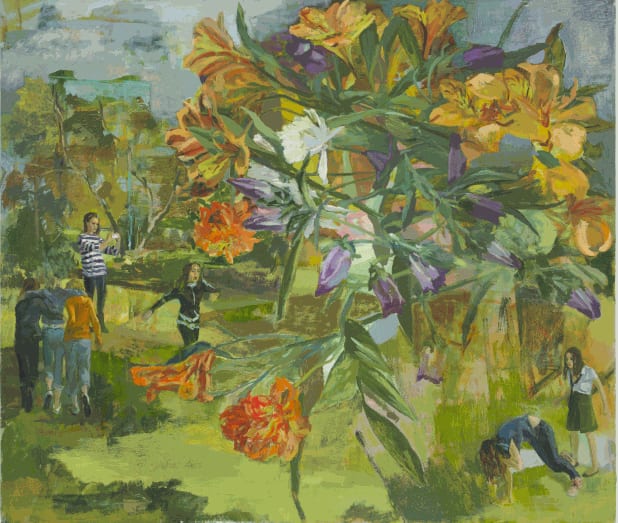The characters of novels often know things the reader doesn’t. What was the life of a character before entering the story or after exiting it? Fictional people have a life that animates their actions, one we have no direct access to, even though they do not themselves “live” without a reader in the way birds and squirrels do. The young women in Vera Iliatova’s eight paintings, now at Monya Rowe Gallery, live within their own stories, cinematic ones, or texts from the artist’s memory and imagination.
Iliatova’s paintings, in as much as I’ve kept up with them, have always been narrative based through their use of “actors,” however opaque in plot. Women in pairs or small groups populate the open-air landscape settings that frequently include bodies of water and thickets of trees. Influenced much by cinema — and I think also Neo Rauch by way of a pastiched framing of events — these new works are richer in psychological texture and physical labor. In “Grey Hour” (2015) two pairs of women stand in the upper right, one discussing homework (indicated by the prep school uniform and sheet of paper clasped by a girl’s side) with the second pair witnessing a traumatic event as one girl covers her eyes. In “Separate Ways” (2015) one teenager snaps a photo with her iPhone of a girl running away in fear.
New to the artist’s work is the appropriation of the still life as a foreground element to the background landscape. This is a motif drawn most explicitly from Jane Freilicher (1924–2014), who painted representationally for 50 years in a style faithful to Vuillard’s. In contrast to Freilicher, however, Iliatova’s floral arrangements are denser, more spatially complicated, more uncertain in their life cycle; some flowers are wilting, losing color and vitality, while others are in full bloom and erect. The physical placement of the still lifes — up front — and in their embodiment of elapsed time become the silent narrators of what we do see and complicit witnesses to what we don’t.
Iliatova’s hand is fluid and commanding without drawing attention to itself. There is often a choppiness to the artist’s gestures, as she makes liberal use of a palette knife for the scraping and spreading of color. The scraping reveals the texture of the canvas weave, whether cotton or linen — and it’s best when it’s linen because the texture is organic and rich. The white primer surfacing through softens and desaturates the color, as does Iliatova’s occasional thinning down of the paint with turpentine. The runs of “turped” paint go in several directions, suggesting Iliatova rotates at times her canvas, building up the picture plane as an abstract painter would. Indeed, many of Iliatova’s moves are of purely abstract or “plastic” motives, such as confusing and conflating spatial planes that ought naturally to be distinct from each other. For example, there is no parsing the foreground from background in areas of the floral densities. The foliage in the background is loose and can look, at times, like painterly fatigue.
We will never know what the girl in “Grey Hour” saw or what in “Separate Ways” gave this woman such fright. Maybe Iliatova herself does not know. Painting, like writing, is often a means of discovering what one thinks and believes as much getting across what one has to say. In these works, Iliatova scrapes down and builds up the lives of girls we can all see, but know only in part.
Read full article here: https://hyperallergic.com/196893/painted-glimpses-of-the-lives-of-fictional-characters/

